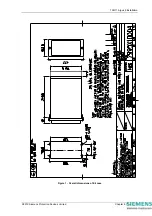
7SG11 Argus 8 Applications Guide
based upon a DFT, coupled with the anti-aliasing filter in the input stage, ensures that any 3
rd
harmonic
present is heavily attenuated and will not cause a mal-trip.
Where a power transformer delta or unearthed star winding is connected to a transformer feeder it is
essential to ensure that this unearthed winding cannot remain energised under system earth-fault
conditions. This condition will result in danger to life and possible hazard to the sound phases due to
intermittent arcing via system earth capacitance. Initiation of tripping may be by means of a neutral
displacement relay arranged to detect residual voltage to earth at the transformer using either a voltage
transformer or coupling capacitors. The relay will operate for external as well as internal feeder faults
and must, therefore, be provided with a time delay to ensure discrimination.
The NVD protection in the relay consists of 2 independent stages which can be used for alarm and trip
purposes. Each has a user settable DTL time delay element associated with it. These are useful for
applications such as insulated systems where, following an earth fault, the phase voltages may have to
withstand sustained overvoltages. An alarm from the first stage can be issued after a short delay to
indicate that there is an earth fault on the system. If this is not satisfactorily cleared then the second
stage can issue a trip signal to isolate the fault.
3.4 NPS Overvoltage Protection
Unbalanced voltage on 3-phase network results as a consequence of unbalanced load current causing
unequal voltage drops in network impedances. The unbalanced load current could be the result of
single phase open circuits (isolator failures, broken conductors etc.), or because of loads generating
harmonics (e.g. thyristor drives). Unbalanced voltage generated at a busbar has the knock-on effect of
causing healthy balanced loads to become unbalanced.
In the case of generators, unbalanced loading causes negative phase sequence (NPS) currents in the
generator stator, which induces double frequency currents in the rotor causing heating of the machine.
If the NPS current exceeds the limit of the generator, protection on the generator will operate and could
result in all the generators connected being tripped. Induction motors also are vulnerable to NPS
current and again, as for generators, NPS overcurrent protection is provided and included on the
majority of industrial plant motors.
The NPS or unbalanced voltage function in the Argus 8 relay can be employed to monitor the quality of
the 3-phase ac supply and thus provide early warning of developing problems of NPS currents, which
might cause tripping of generators or motors. In this respect the NPS overvoltage protection is very
beneficial.
The NPS protection consists of 2 independent stages, each with a user settable DTL time delay
element associated with it. These can be used for both alarm and tripping purposes.
Where the 3-phase VT’s supplying an Argus 8 relay are protected by fuses, special consideration has
to be made. Any single fuse operating e.g. due to ageing or a winding / wiring fault, will result in NPS
voltage in the input to the relay. Where miniature circuit breakers (MCB’s) are employed they can be
provided with an “all phases trip” feature which prevents the mal-operation of an NPS voltage
monitoring relay. (An “all phases trip” MCB will operate for any fault condition). However, where fuses
are employed, allowance must be made for the impact of a single fuse operation. If the NPS
overvoltage function of the relay is used only for alarm purposes, there is no serious consequence. If,
however if it used for delayed tripping, then consideration should be given to blocking for single fuse
failure. One method is to use the two separate NPS stages, one set as a high set instantaneous for
blocking a trip and the other as a lower set, time delayed stage for protection of the rotating plant.
However, a problem arises in that a broken primary circuit phase has a similar effect to single fuse
operation. The preferred solution is to provide MCB’s with an “all phases trip” feature for the secondary
circuit protection.
3.5 Frequency Protection
When a power system is in stable operation at normal frequency, the total mechanical power input from
the prime movers to the generators is equal to the sum of all the connected loads, plus all real power
losses in the system. Any frequency variation is an indication of generator-load imbalance in the
system. If an interconnected system splits, for example, there might be a situation where the load in
one of the subsystems is in excess of the generator capacity in that subsystem. In this instance the
generator speed will begin to decrease causing a proportional frequency drop. An underfrequency
condition at nominal voltage can lead to over-fluxing of plant such as generators and transformers. If
the governors and other regulating equipment cannot respond quickly enough, a sustained
underfrequency condition may lead to a system collapse. Conversely, if there is an excess of
generation in the subsystem then the generator speed will increase causing a proportional frequency
©2010 Siemens Protection Devices Limited
Chapter 5 Page 6 of 16
Содержание AG8 101-103
Страница 1: ...Reyrolle Protection Devices 7SG11 Argus 8 Voltage and Frequency Relays Answers for energy ...
Страница 96: ...7SG11 Argus 8 Appendix Notes Pages Notes Pages 2010 Siemens Protection Devices Limited Chapter 9 Page 10 of 13 ...
Страница 97: ...7SG11 Argus 8 Appendix 2010 Siemens Protection Devices Limited Chapter 9 Page 11 of 13 ...
Страница 98: ...7SG11 Argus 8 Appendix Notes Pages 2010 Siemens Protection Devices Limited Chapter 9 Page 12 of 13 ...
Страница 99: ...7SG11 Argus 8 Appendix 2010 Siemens Protection Devices Limited Chapter 9 Page 13 of 13 Notes Pages ...
















































